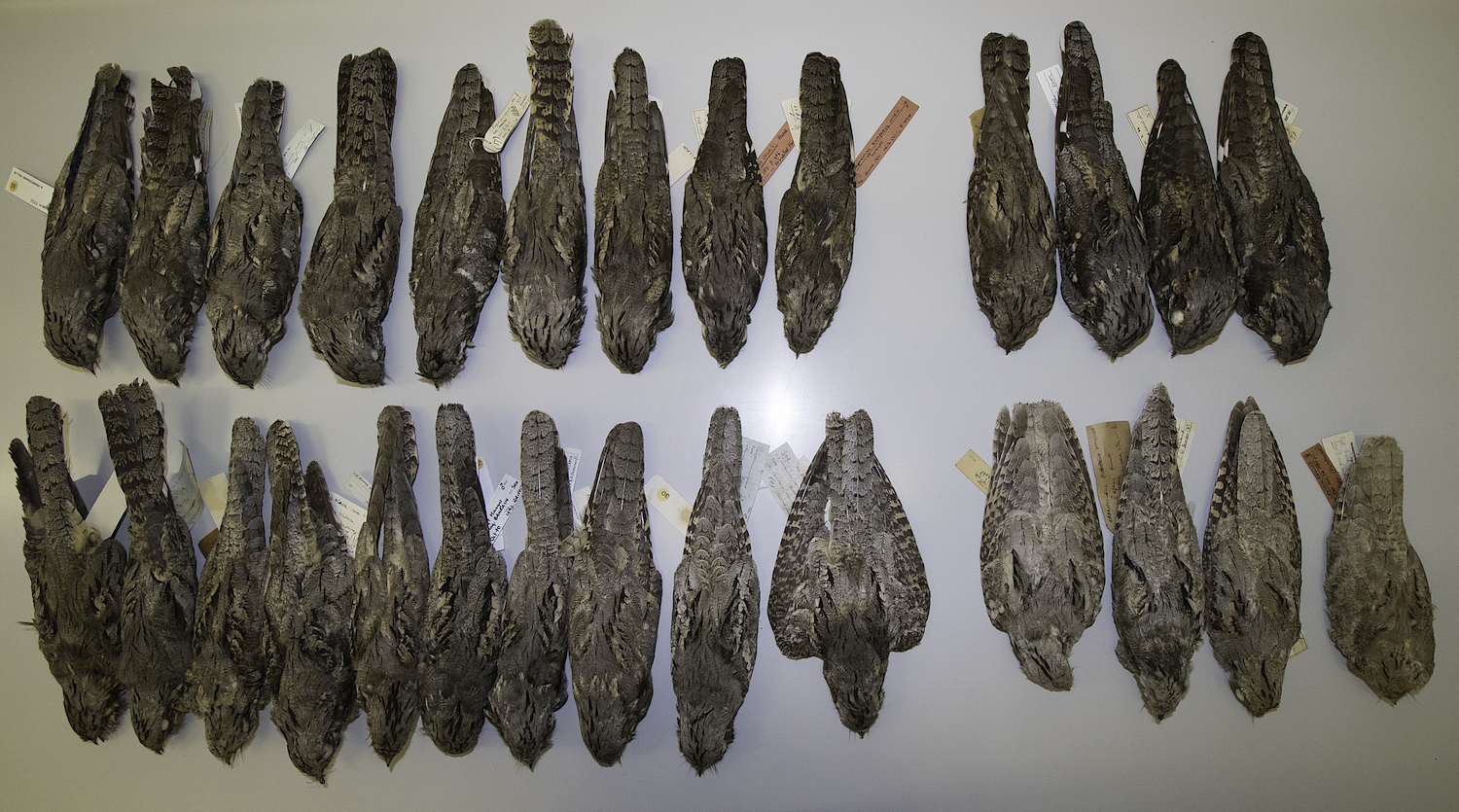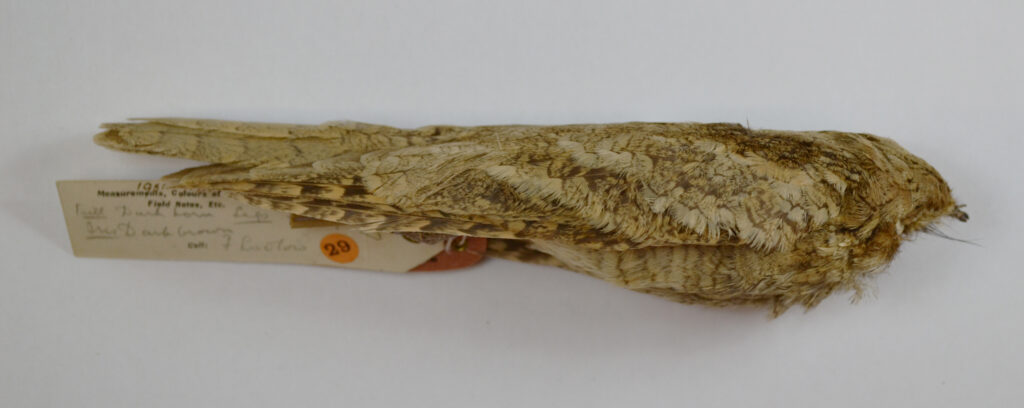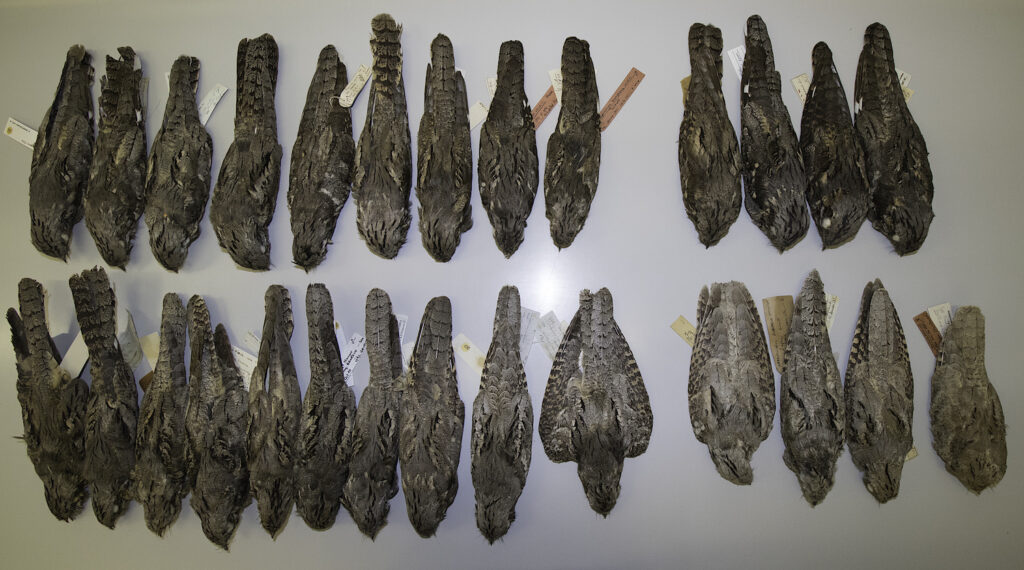
Caprimulgus centralasicus skins
Some of the specimens assembled for the morphological analysis, with the Vaurie’s Nightjar (Caprimulgus centralasicus) type lower right (Hadoram Shirihai © Natural History Museum, London)
Caprimulgus centralasicus is known solely from the type specimen, collected by Frank Ludlow in September 1929, at ‘Goma’, on the southern edge of the Taklamakan Desert in Xinjiang, in extreme north-west China, and described by Charles Vaurie (Vaurie 1960). Initially, the specimen was thought to be one of two nightjar specimens from China identified as Egyptian Nightjar C. aegyptius (Ludlow & Kinnear 1933), neither of which can now be confirmed.
The specimen, still held in the Natural History Museum at Tring (NHMUK 1931.7.8.256), has been almost universally referred to as Vaurie’s Nightjar since, and due to the lack of subsequent encounters with the species has become one of the greatest mysteries in Asian ornithology, if not the world (Butchart et al. 2005, Leader 2009).

In tandem with the now seemingly universal application of molecular techniques to solve more ‘routine’ questions in avian taxonomy, genetic tools are increasingly being deployed to resolve the mysteries inherent to unique specimens, such as the Liberian Greenbul Phyllastrephus leucolepis (Western Africa), Hooded Seedeater Sporophila melanops (central Brazil) and Bogota Sunangel Heliangelus zusii (Colombia). All three had been widely recognized as species, but following detailed genetic and morphological work are now believed to represent a variant of the common Icterine Greenbul Phyllastrephus icterinus (Collinson et al. 2018), a melanistic Dark-throated Seedeater Sporophila ruficollis (Areta et al. 2016), and a hybrid (Pérez-Emán et al. 2018), respectively.
Building on previous efforts to elucidate whether Vaurie’s Nightjar is really a valid species, for example by Nigel Cleere and, separately, Paul Leader, our investigations commenced with renewed morphological comparisons by Hadoram Shirihai and Guy Kirwan. Furthermore, with assistance from curators at NHMUK, destructive samples for genetic work were taken from the specimen and tested in two separate laboratories, in Bonn (Germany) and Bern (Switzerland). The samples were compared with a variety of other species of nightjars.

The genetic work, coordinated by Manuel Schweizer and Till Töpfer, with assistance from Claudia Etzbauer, was productive on multiple levels. We found that C. centralasicus has an identical partial fragment of the mitochondrial gene cytochrome oxidase subunit 1 b (COI) as five European Nightjars C. europaeus, taken, in Iran, Kyrgyzstan and Russia, some of which were almost certainly on migration. Although we recovered marked phylogeographic structure within European Nightjar, its correspondence with morphological, especially plumage variation, requires further investigation using a more comprehensive geographic sampling from the breeding grounds. However, based on current data, there is no correspondence between the described subspecies of C. europaeus and genetic variability. In addition, our comparisons also revealed deep genetic variation within the principally East African and Arabian distributed Nubian Nightjar C. nubicus. These issues offer hot topics for future research, to be pursued by ourselves and colleagues.
The overall plumage coloration of C. centralasicus is similar, especially on the upperparts, to at least some specimens of C. europaeus of the subspecies C. e. unwini and C. e. plumipes, and by implication to that of C. e. dementievi too, although we have been unable to examine any specimens of the latter.
Our investigations suggest that it is highly likely that Vaurie’s Nightjar is a synonym of C. e. plumipes, and thus a subspecies of European Nightjar. The small size of the holotype compared to C. europaeus, which has frequently been invoked as one of the prime reasons for accepting it as a species, is still difficult to fully rationalize.
However, we believe that the Goma specimen, which has usually been considered to be an adult, is in fact a fledgling in its first plumage, parts of which are still growing, and this would explain much of the difference in size.
The full results have been published recently in the Journal of Ornithology (Schweizer et al. 2020), available at https://doi.org/10.1007/s10336-020-01767-8.
References
Areta, J. I., V. Q. Piacentini, E. Haring, A. Gamauf, L. F. Silveira, E. Machado, and G. M. Kirwan (2016). Tiny bird, huge mystery—the possibly extinct hooded seedeater (Sporophila melanops) is a capuchino with a melanistic cap. PLoS ONE 11(7).
Butchart, S. H. M., M. J. Crosby, N. J. Collar, and J. A. Tobias (2005). Lost and poorly known birds: top targets for birders in Asia. BirdingASIA 3: 41–49.
Collinson, J. M., M. Päckert, Y. Lawrie, W. Gatter, T. Töpfer, B. Phalan, and L. D. C. Fishpool (2018). Taxonomic status of the Liberian Greenbul Phyllastrephus leucolepis and the conservation importance of the Cavalla Forest, Liberia. Journal of Ornithology 159: 19–27.
Leader, P. J. (2009). Is Vaurie’s Nightjar Caprimulgus centralasicus a valid species? BirdingASIA 11: 47–50.
Ludlow, F., and N. B. Kinnear (1933). A contribution to the ornithology of Chinese Turkestan, part 3. Ibis 75: 658–694.
Pérez-Emán, J. L., J. P. Ferreira, N. Gutiérrez-Pinto, A. M. Cuervo, L. N. Céspedes, C. C. Witt, and C. D. Cadena (2018). An extinct hummingbird species that never was: a cautionary tale about sampling issues in molecular phylogenetics. Zootaxa 4442: 491–497.
Schweizer, M., C. Etzbauer, H. Shirihai, T. Töpfer, and G. M. Kirwan (2020). A molecular analysis of the mysterious Vaurie’s Nightjar Caprimulgus centralasicus yields fresh insight into its taxonomic status. Journal of Ornithology https://doi.org/10.1007/s10336-020-01767-8
Vaurie, C. (1960). Systematic notes on Palearctic birds, No. 39: Caprimulgidae: a new species of Caprimulgus. American Museum Novitates 1985: 1–10.

Partnerships
A global alliance of nature organizations working to document the natural history of all bird species at an unprecedented scale.
















